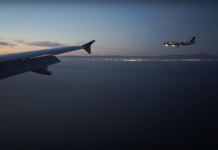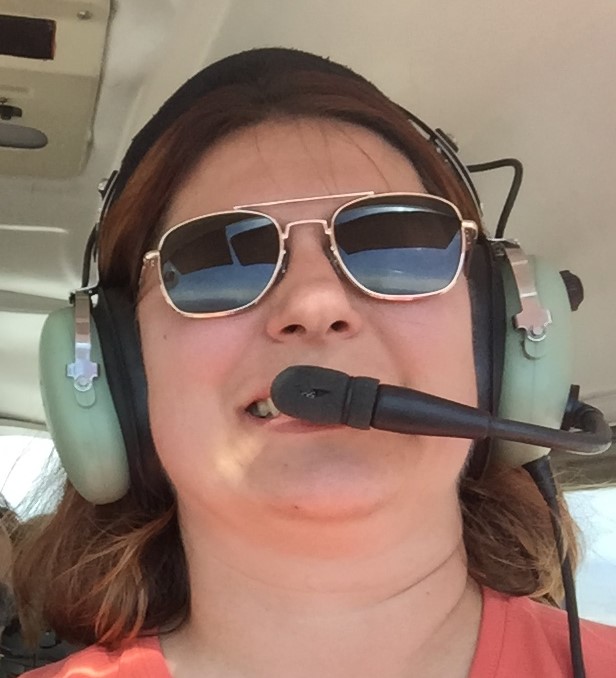In the United States, which is where I do all my flying, airspace classes are there to assist with the growing number of planes in the sky. Since there is no established roadways in the sky there needs to be some way to ensure that pilots don’t run into each other.
As you may have guessed there are some areas of the country that have more air traffic than others. For example, the Dallas/Ft. Worth area has waaaaay more traffic than say the rural areas of New Mexico. So, how do we determine what rules apply to which areas? How can we tell what the airspace is above our heads? What about when we are flying, how do we know what type of airspace we are operating in?
The answers to these questions are in Airspace Classes.

What is an Airspace Class?
Airspace classes are divided into three main categories, Controlled, “Uncontrolled” and Special Use/Other. The uncontrolled airspace does not mean that anything goes, only that an air traffic controller is not monitoring and actively routing planes through those areas. Controlled space is the opposite. There is an air traffic controller monitoring that airspace and providing services to IFR flights and VFR when their work load permits.
The United States uses the ICAO definitions of airspace. These are as follows:
- Controlled Airspace:
- Class A
- Class B
- Class C
- Class D
- Class E
- Uncontrolled Airspace:
- Class G
- Special Use Airspace:
- Restricted Airspace
- Prohibited Airspace
- Military Operating Areas
- Air Defense Identification Zone
- Other Airspace:
- Temporary Flight Restrictions
- Special Flight Rules Areas
Any point in the air can only have 1 classification of airspace. For example, you cannot be flying in both Class B and Class D airspace. Based on your physical location over the ground as well as your altitude you will only be in a single type of airspace.
You may have noticed that there is no Class F airspace listed. This airspace is not used in the US. There are other places around the world that use this designation however, so it still exists as a class.
Lastly, what’s up with the special use airspace and the “other” airspace? Well, to put it plainly, those are areas where different rules apply from the ‘normal’ classification of A-G airspace.
Airspace Classes
Here is the down and dirty for each of the classes listed above. I will be writing a post on each class in the coming weeks and linking back here. So, keep coming back and check out the more detailed information.
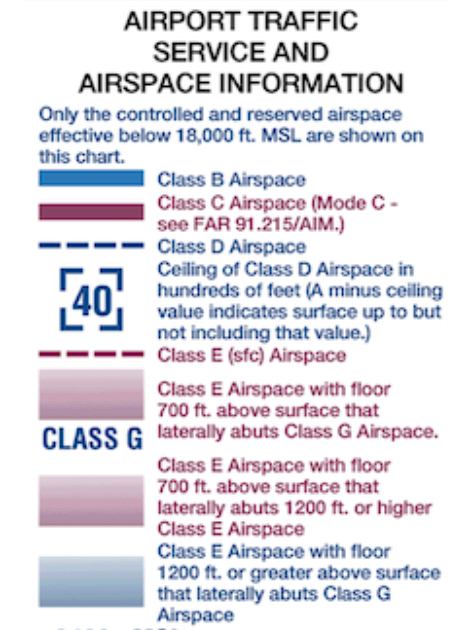
Class A
Our first airspace is Class A. This is probably the easiest of all the airspace. It is above the entire United States starting at 18,000 feet MSL (mean sea level) and going up to and including 60,000 feet MSL. For ease of communication the altitudes flown in class A are usually defined by flight levels. A flight level is shown as FL600 or “Flight Level 600”. This means 60,000 feet. The first two numbers in a flight level are the “thousands” and the third number is the hundreds designation.
Unique to Class A, any plane flying in class A must use the standard pressure setting of 29.92″ Hg in their Kollsman Window. Due to this fact and not setting the actual pressure of the local area, the altitude for class A technically varies depending on the barometric pressure.
Class A airspace is IFR or Instrument Flight Rules only. It is controlled entirely by Air Traffic Control. You must receive clearance to enter class A airspace. This means you must hear the words “Cleared to Enter Class B” or along those lines before you may cross into the airspace.
Due to the nature of class A being over the entire United States it is NOT shown on any VFR charts.
For a more in depth look at Class A airspace, check out my blog post going into great detail.
Class B
Think of class B airspace as “Busy”. This airspace is for areas of significant traffic and increased IFR operations. Due to the nature of how planes fly in and out of an airport the airspace looks like an upside-down wedding cake. The smallest section of class B being around the airport, the next largest layer is above that extending out a few nautical miles and the last layer above that. The increased IFR operations requires ATC to have significant control over the planes and where they are.
Class B airspace usually starts at the surface and goes up to 10,000 feet MSL. Each class B is tailored to the specific area so may have some differences and nuances to them.
A pilot must receive ATC clearance to enter the class B. The plane also must have two-way radio communications and a Mode C transponder.
Each class B has a Mode C veil that stretches out 30 Nautical Miles from the center of the class B. ALL aircraft that crosses that veil must have a functioning Mode C transponder, regardless of if they are entering the class B airspace or flying under it.
Due to the nature of the operations and sheer volume of planes in class B airspace it has the strictest rules of any other airspace.
Looking for more information about Class B? Check out my blog post here that goes into more detail.
Class C
Class C airspace is similar to Class B with less stringent regulations. The shape of the airspace is usually two layers with the bottom layer being the smallest in diameter. The height of class C generally goes to 4,000 feet Above ground level (AGL). The actual top is listed in MSL on a chart. Much the same as class B airspace, each Class C is tailored to each airport individually.
Class C requires two-way radio communications and Mode C transponder for entry into the airspace. You must establish communications with ATC before entering Class C airspace but you do NOT need clearance to enter.
What does establish communications mean? It means that you have talked to the controller and they have acknowledged you by your tail number.
For example:
Pilot: "Approach, Cessna N12345" Approach: "Cessna N12345, standby"
The above is an example of established communications.
Pilot: "Approach, Cessna N12345" Approach: "Calling aircraft, standby"
The above is NOT established communications. If you hear this you are NOT cleared to enter the class C airspace. The controller has to call you by your tail number.
Class D
Airspace created for airports that have active control towers but may not see a significant amount of IFR traffic. Class D airports are not usually where passenger airlines come in and out of. Often these airports are for General Aviation, flight schools and other non commercial flights.
The general class D airspace is a single cylindrical layer. Averaging 4 Nautical miles from the center and usually up to 2,500 feet AGL. Some class D’s have radar, but most are the old school way of binoculars and visually spotting traffic.
Two-way communication is required to enter Class D, but unlike all other airspace so far, Mode C transponders are NOT required.
This airspace reverts to either Class E or Class G when the tower is not in operation. You can find which specific airspace it becomes by checking the Airport Facilities Directory for the requested airport.
Class E
Class E is all remaining controlled airspace that is NOT Class A, B, C, D or G. This is the airspace over most of the continental US. It is the only controlled airspace where radios are not required. There are also no pilot requirements, meaning you can be a student pilot and fly in class E airspace without any specific endorsements from your instructor other than your ability to solo.
Technically class E airspace exists from either 700 feet AGL or 1200 feet AGL and goes up to and including 17,999 feet. Also, the airspace above Class A is also registered as Class E. However, most commercial planes don’t fly above 60,000 feet and the few planes that do belong to the government.
This is the least restrictive controlled airspace. If you are flying VFR you do not need to talk to anyone the entire time you are in this space. If you are flying IFR you do need clearance and to remain in contact with ATC.
Class G
This is the first, and only uncontrolled airspace in the United States. Being uncontrolled, there are very few limitations for flying in this airspace class. This is the space underneath all other listed airspaces. It is between 700 feet AGL and 1200 feet AGL.
There are rare occasions where Class G extends above 1200 feet AGL. You may see it in mountainous areas. Sometimes you find it in sparsely populated areas, like some areas in Montana. Many airports are surrounded by class G airspace close to the ground.
There are no requirements for communication and no special requirements for equipment in Class G airspace. Most pilots enter class G as they are transitioning from other airspace classes either during takeoff and landing.
Special Use
There are many different types of special use airspace. These airspace classes do not have correlating ICAO designations but they are found throughout the US.

Restricted Airspace
This is airspace where normal plane operation is not authorized. You must first receive clearance from the controlling authority of the airspace. Entry into this type of airspace without proper clearance may result in an interception and forced landing.
Prohibited Airspace
While restricted airspace requires clearance, prohibited airspace is just that. Prohibited. No aircraft operations may happen in this area. Entrance into these areas are certain to be met with interception or possibly even being shot down depending on the reason for the prohibited status.
Military Operation Areas (MOAs)
These are areas where the military may be conducting training. Such as hazardous maneuvers and flight above the normal speed limit for the altitude. This training could be detrimental to other unsuspecting aircraft. The MOAs will have operating times and altitudes where the operation is active. Check all available NOTAMS to determine if the MOA is active.
Civilian operation in a MOA is authorized and no clearance is required to enter a MOA. However, it is the duty of all pilots to be on high alert as there may be high speed military operations that make plane spotting difficult.
Air Defense Identification Zone (ADIZ)
The ADIZ airspace is an area surrounding the coastal United States and Canada. Entrance into this airspace requires authorization. This is the first barrier of entry for the airspace of the United States from foreign countries.
Unauthorized flight into this area may result in your aircraft being treated as hostile enemy aircraft. I would expect either interception or worse.
Other Airspace
Lastly there are two types of airspace that really don’t meet any of the above mentioned definitions. They are TFRs and the SFRA of Washington DC.
Temporary Flight Restrictions (TFR)
There are many reasons that the FAA may choose to change the airspace around a temporary point. These restrictions have individual rules that apply to them and they are listed in the NOTAMS about the TFR.
Temporary flight restrictions are just that, a temporary set time where normal aircraft operations are restricted or prohibited. These pop up in airspace for several reasons. Some of the more common reasons are:
- Sports Arenas during Sporting Events
- Presidential Movement
- Wildfires
- Rocket launching
This is by no means an exhaustive list. TFRs are active for a variety of reasons. Each one has a specific starting time, radius and location that can all be found in the Notices to Airmen.
Special Flight Rules Area (SFRA)
Some areas are even more out of the norm to keep a standard airspace class or even a special use class. These areas are known as special flight rules areas. Washington DC is one location that has a very extensive SFRA. Due to national security there are many restrictions that apply to flights around our nation’s capital.
Other areas such as Los Angeles has an SFRA as well as the Grand Canyon. These SFRAs all have individual rules regarding the type of flying that can be done in their areas.
The DC SFRA requires special training and an online test showing competency regarding the SFRA before you may enter the area. Other SFRAs are modifications to the designated airspace rules.
Testing Your Knowledge
Now that you know a little more about each airspace class let’s play a little game my private pilot instructor use to call “What airspace is above my head?”
First Spot
Let’s start out easy with this one.
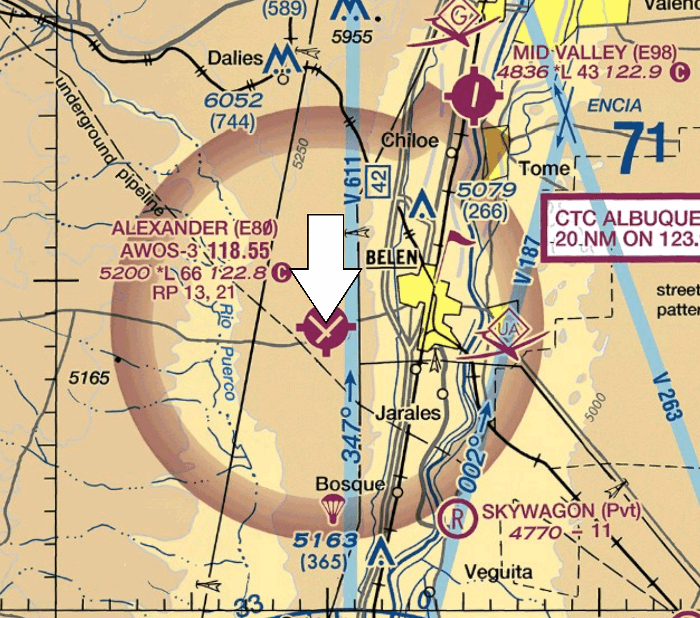
How do you start looking at something like this? Well, I start at the point and work my way out.
Step 1: Does the point (airport in this case) have any immediately surrounding data that shows the airspace to the surface (usually dashed lines or something showing SFC)? Not on this one.
Step 2: Expand you search out to see if there is any additional airspace information. YES! On this point we have a CLASS E airspace with floor 700ft above the surface notation.
Step 3: Determine your Airspace from the surface.
- 0 ft AGL – 699 ft AGL = CLASS G
- 700 ft AGL – 17,999 ft MSL = CLASS E
- 18,000 ft MSL – 60,000 ft MSL = CLASS A
- 60,001+ ft = CLASS E
How did you do on that one? Want to try another one?
Second Spot
Now it’s time to turn on the pressure.
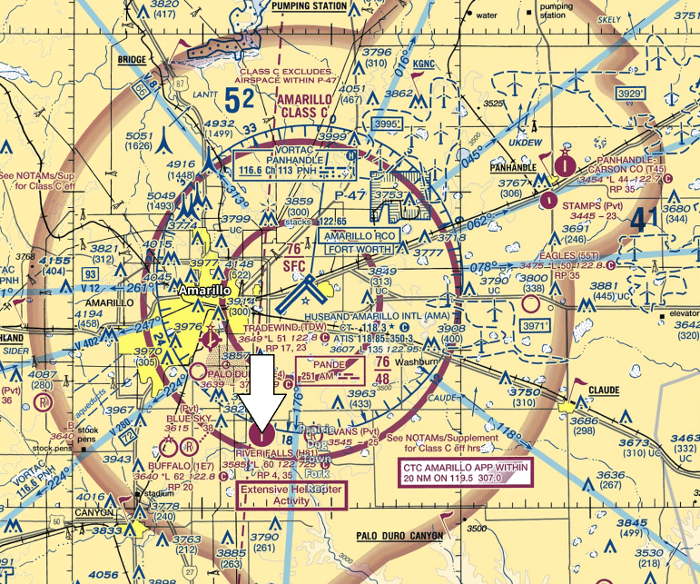
Same steps as before, start at the point and work your way out to determine the airspace.
Step 1: Check the immediate area to see if you have an airspace that goes to the surface. Not on this one.
Step 2: Go a little farther out and see what airspace may be around your point. We have a Class C shelf above our head. We are in the 76/48 shelf. Meaning the bottom of that shelf is at 4,800 feet MSL and the top of the shelf is at 7,600 feet MSL.
Step 3: Go out farther and see if there is any additional airspace. We find a Class E from 700 feet AGL to 1,200 feet AGL.
Step 4: Put it all together.
- 0 ft – 699 ft AGL = Class G
- 700 ft AGL (4,285 MSL) – 4,799 ft MSL = Class E
- 4,800 ft MSL – 7,600 ft MSL = Class C
- 7,601 ft MSL – 17,999 ft MSL = Class E
- 18,000 ft MSL – 60,000 ft MS = Class A
- 60,001+ ft MSL = Class E
How did you do? Did you catch all the airspace class changes? Altitude is very important when you are going through areas such as this. This type of exercise is good to do every so often to make sure you are still sharp with your airspaces.
Your turn!
Pick a spot on your aeronautical charts and see if you can determine what the airspace is all the way up to FL600. The more you do this the better you become at recognizing what type of airspace you may be in based on where you are in the air. This makes you a better, safer, more informed pilot.
Conclusion
To the non-pilot, the sky looks like a wide open field where you can go where ever you want. New pilots see a mess of airspace classes that you need to remember or you may get yourself in hot water. For those of us who have been flying for a while, it’s a nice reminder of the basics and maybe you learned a thing or two.
Do you have a better way to understand each airspace? Have you tried the what airspace is above you exercise before? Let me know your thoughts in the comments.
